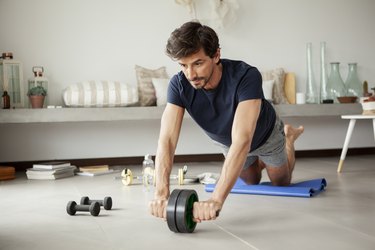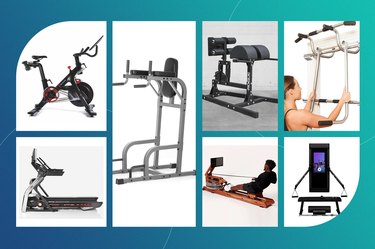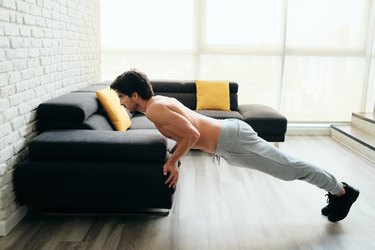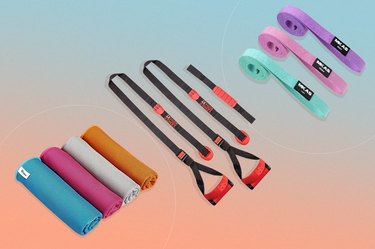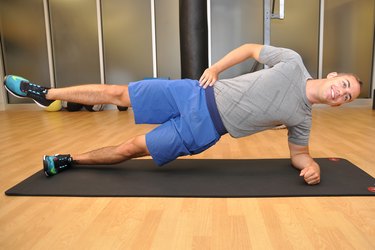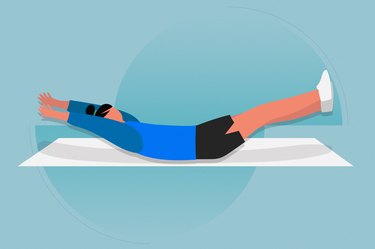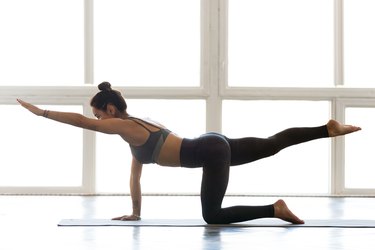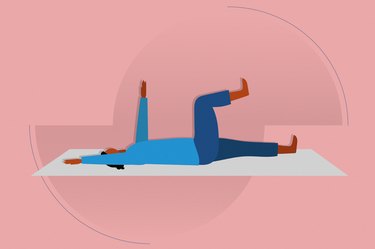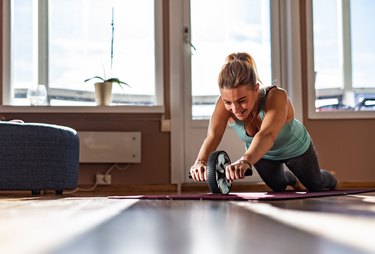

The ab roller, aka ab wheel, is one of those pieces of exercise equipment that seems like it belongs in an old VHS workout video, not in the 21st century.
Maybe you've seen one at the gym and overlooked it because you assumed it was outdated or useless. Well, turns out there's a reason it has stood the test of time: The ab roller benefits muscles throughout your core, back, arms and glutes — helping to improve your functional strength, stability, posture and overall fitness.
Video of the Day
"The ab roller is a useful tool in taking your ab training to the next level, and continuing to develop your overall core strength and control," Peri Lindh, CPT, a certified personal trainer at Parker Cote Elite Fitness in Boston, tells LIVESTRONG.com. "The two-handled wheel might appear to be small and simple, but can be deceivingly difficult in how it works. It truly challenges your overall core strength as well as upper body."
Bonus: Ab wheels are are not just effective. They are also inexpensive and space-saving pieces of at-home workout equipment.
Our Favorite Ab Rollers
6 Ab Roller Benefits
1. More Defined Core
The most obvious benefit of the ab roller is that it works your abs — hard.
"The rectus abdominis, commonly known for being the 'six-pack' part of the abs, is the main driver of the ab wheel rollout," she says.
The wheel doesn't only work that one muscle, though. It also recruits the transverse abdominis (the deepest core muscles), internal and external obliques (muscles along the sides of the core) and lower back muscles, Lindh says.
Having a strong core will benefit you in endless ways.
"Strong abdominals and a strong core as a whole translate to improved daily living and functionality in everyday life," Lindh says.
Better balance, increased muscular endurance, reduced risk of injury and improved posture are just some of the big benefits you get from keeping your midsection strong. If you're hoping to get that six-pack look, this can also help. (Remember, though, that nutrition and genetics play a huge role and you can't just ab roll your way to a six pack).
2. Stronger Upper Body
But wait! The ab roller benefits not just your core, but your entire upper body.
It might be surprising, but it makes sense: You have to use your entire torso to keep your spine straight and strong as you roll out and back in.
"Lats, deltoids, erector spinae, chest, biceps and triceps are all recruited to help in the rolling motion of the exercise."
3. More Stable Hips
While your lower body doesn't do quite as much work during ab wheel rollouts, you may also feel your hip flexors and glutes engaging. Remember, the hips are technically part of your core. "Overall, the ab wheel requires a lot of total-body cohesive control," she says.
For the greatest ab roller benefits, keep your glutes squeezed as tight as possible.
4. Functional Strength
Again, the roller doesn't just work the abs; it works every part of what we call the "core." Beyond just building strength, using the exercise tool also teaches your core to work together — which is how it functions in everyday life.
"It's an excellent way to work the core as a unit, and improve the functionality of all of [the included muscle groups] together," Lindh says. Functional training keeps your body balanced and ready for anything, and is what keeps you able to move and exercise how you want to without getting injured.
Bonus: By working so many muscle groups at once, you exert more energy and recruit more muscle fibers than if you isolate one at a time, Lindh says. This leads to more muscle growth and a higher calorie burn.
5. Better Posture and Lower Back Health
"Your core is in charge of a number of key functions such as trunk flexion and extension, lateral flexion, rotation and bracing. It is also responsible for the control and stabilization against these functions," Lindh explains. Think: movement that might be harmful to the spine.
Specifically, the wheel trains your core to resist extension, when your lower back arches. While some slight curvature in the lower portion of your spine (aka lumbar spine) is good, too much increases the amount of stress both on your spine and the supporting muscles.
Excessive lumbar extension is one of the most common causes of lower back pain.
6. Safer Exercise Form
Anti-extension work helps protect your back not just when you're sitting at the computer, but also when running and lifting weights. You may intentionally arch your back during certain stretches and exercises, but overarching the spine can lead to injury, Lindh says.
"The wheel is a great way to improve your overall form on many other lifts," she says. Keeping a neutral spine is very important in most exercises, but is critical to doing overhead shoulder presses, squats and deadlifts with safe and effective form.
Don't worry. We'll explain how to achieve anti-extension below.
Is the Ab Roller Effective?
If the above list of ab wheel benefits wasn't enough to convince you... yes, let us say right here that the ab roller is effective.
Now, if you're looking for an exercise that isolates your abs, the roller is not that.
But if you're looking to challenge your entire core and gain strength and coordination, then the ab wheel is a great tool to intensify your core and even total-body workouts.
"For someone who has already developed a super solid foundation of core and upper-body strength, and is looking to progress and challenge themselves, this is a great option," Lindh says.
3 Common Ab Roller Mistakes
That said, like any other exercise, the wheel is only effective if you use it correctly. And mistakes can undo some of the benefits of ab rollouts, not to mention put your lower back at risk of pain and injury.
1. Arching Your Back
Lindh says that the most common mistake she sees with this move is doing it with an anterior pelvic tilt. "Starting with this form — arched back, loose core — sets you up for failure from the get go," she says.
You may not have your core braced enough to get through the movement without dropping to the floor, and if you do, you may end up putting too much stress on your lower back. So not only will it not work so well, but you'll end up hurting.
2. Letting Your Hip Flexors Take Over
"Another mistake commonly seen is using your hip flexors as a driving force for this move," Lindh adds. "This would look like someone sitting all the way back onto their heels at the top of the rollout, and completely flexing the hips to draw back in instead of intentionally using the abdominal muscles."
3. Doing Too Many Reps, Too Fast
For the greatest ab wheel benefits, focus on quality over quantity. "A quality rep is one that is performed with intention and good mind-muscle connection. The roller is not meant to be used to bust out a high volume of meaningless reps, but rather with more time under tension and more control," Lindh says.
How to Use an Ab Roller
No matter your current strength levels, only do as many reps per set as you comfortably can while maintaining excellent control and without letting you lower back arch. Is that means doing 1 rep per set, cool!
The moment you feel — and ideally, before you even feel — your back arching or hip flexors taking over, stop your set. Rest for 30 to 60 seconds, then give it another go.
Here, Lindh walks you through exactly how to do an ab wheel rollout with perfect, effective form.
Ab Wheel Rollout
- Set up on all fours on a flat, hard surface. Place a cushion, mat or towel underneath your knees for support.
- Engage your core and tuck your pelvis underneath you to reduce the arch in your lower back. You want to maintain a solid core and neutral spine throughout the entire exercise.
- Grab onto the ab wheel's handles. Your back should be rounded in the starting position, but your core should still be completely engaged.
- Slowly roll forward, using your core to control the movement. Your back should extend a bit as you roll so that you move into a plank position.
- Roll as far out as you can while still maintaining a tight core and flat back.
- Use your core and back muscles to roll the wheel back toward your body and return to the starting position.
Tip
If you can’t yet master the roll-out and roll-in with a rock-solid core and stable spine, Lindh recommends going back and working on mastering a plank first.
“Once you have developed the foundational core strength there, move on to plank walkouts. You can also use a Swiss ball to mimic small variations of the rollout.”
After shoring up your core with these moves, try the ab wheel again.
